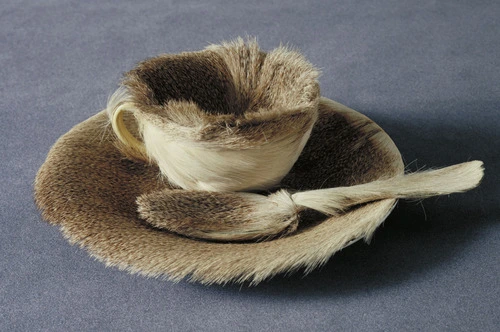Object (Le Déjeuner en fourrure) its name literally means The Luncheon in fur, but it is also known in English as Fur Breakfast or Breakfast in fur. It’s a sculpture created by the surrealist artist Meret Oppenheim.
This work is the example more frequently-cited of surrealist sculptures. It is also considerable as a work with challenging themes related to femininity. It consists in fur covered teacup, saucer and spoon.
The idea:
The concept of this work was originated as a joke during a conversation among the artist and her two friends Dora Mar and Pablo Picasso at a Parisian café. They were discussing the café’s social role. By that time, Oppenheim was nearly 23 years old.

Le Déjeuner en fourrure was exhibited as part of André Breton’s first exhibition of surrealist sculpture (Exposition surréaliste d’objets) at the Galerie Charles Ratton in 1936. Its first name was Cup, saucer and spoon covered with fur, but Breton renamed it in reference to Édouard Manet’s painting Le Déjeuner sur l’herbe.
This work exemplifies really well Breton’s argument that mundane things presented in an unexpected way had the power to challenge the reason, to urge the inhibited or uninitiated (the most of society) to connect to their subconscious, even if they weren’t ready for it. These theories, he developed in the essay The crisis of the object.
Later in the same year, it was exhibited in London at the London International Surrealist Exhibition and in the winter 1936/37 at the Museum of Modern Art in New York, there the visitors selected it as “the quintessential Surrealist object”. After the exhibition the MoMA purchased the work where it remains as part of the permanent collection.
Understanding:
In this work Oppenheim combines the domesticity of the tea set with the eroticism and animality of the fur covering. The tea sets were part of tradition of feminine decorative arts.
Just as in other works of the surrealist movement, a visual pun is implied, also is highlighted the incongruity and impracticability of the combined elements.
A former director of Tate Modern, Will Gompertz, wrote about this sculpture:
The sexual connotations of Object (Le Déjeuner en Fourrure) are obvious: drinking from the furry cup is an explicit sexual reference. But there is much more to it than a saucy joke. The image of a fur-lined cup and spoon would not be out of place in the first chapter of any book about anxiety nightmares, in which any pretense of being in control is subverted by sinister happenings. In this instance, a cup and spoon has grown hair, turning objects from which one should derive relaxation and pleasure into something aggressive, unpleasant and faintly disgusting. It has connotations of bourgeoise guilt: for wasting time gossiping in cafés and mistreating beautiful animals (the fur is from a Chinese gazelle). It is also an object designed to engender madness. Two incompatible materials have been brought together to create one troubling vessel. Fur is pleasing to touch, but horrible when you put it in your mouth. You want to drink from the cup and eat from the spoon—that is their purpose—but the sensation of the fur is too repulsive. It’s a maddening cycle.”









You must be logged in to post a comment.